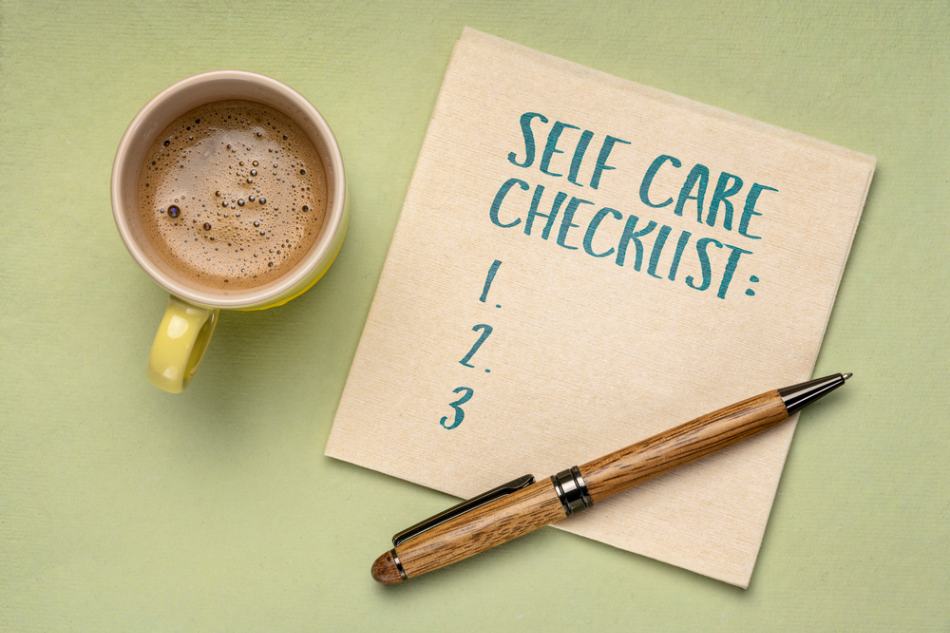November 9, 2023
Webinar: Coping with Anxiety and Perfectionism in Young Adulthood
Written by Rachel Eddins
Posted in Anxiety, Webinars and with tags: Anxiety, anxiety in teens

This webinar is for young adults aged 18-33 whose career and personal lives have been impacted by anxiety and perfectionism. Symptoms of anxiety and perfectionism can impact self-confidence and lead to feelings of guilt and shame.
Young adults experiencing this often compare their lives and achievements to others, battle negative self-talk, and even show signs of depression. This can result in an endless cycle of not feeling good enough, self-doubt, black-and-white thinking, procrastination, and anxiety.
After attending this presentation, young adults will feel more knowledgeable and confident in how they cope with anxiety and perfectionism, will be able to practice more self-compassion, and will experience less worry, self-criticism, and anxiety.
This webinar will help young adults learn to identify and cope with symptoms of anxiety and perfectionism so they are able to lessen its impact on their personal and professional lives.
Presented by Jennifer Oates, LPC Associate, supervised by Heather Murphy, M.A., LPC-S.
Watch a replay of the presentation here.
Hello, my name is Jennifer Oates. I’m an L. P. C. Associate, which stands for licensed professional counselor associate at Eddins Counseling Group in Houston, Texas. I graduated with my Master’s in Clinical Mental Health Counseling from the University of Houston, Clear Lake this past May. I’m a new associate, and I am accumulating hours to head towards full clinical licensure, hopefully in the next year.
Today’s topic is “Coping with Anxiety and Perfectionism in Young Adulthood”. This webinar is part of the free monthly webinar series by Eddins Counseling Group which offers a variety of mental health topics. Previous topics included mitigating symptoms of OCD (obsessive-compulsive disorder), learning about grief, insomnia, couples communication, and various other mental health topics.
Perfectionism and Anxiety Overview
This webinar is intended to be an introduction to the concepts of coping with anxiety and perfectionism. If you already are familiar with the way that the body processes anxiety and/or certain types of therapeutic approaches to mitigating anxiety and perfectionist thinking, then this presentation might feel like a review to you.
The objectives here are pretty lofty for only an hour-long webinar, but I’m going to do my best to make sure that we address each of them and that they feed into one another so that you feel like you’re getting the best use out of this time.
Those objectives are:
- Gain more knowledge and more confidence in your ability to cope.
- Increase self-compassion.
- Decrease feelings of worry, self-criticism, and anxiety.
- Apply lessons to personal, academic, and professional aspects of your life
Clinical Definition of “Anxiety”
Generalized Anxiety Disorder
There’s a lot of information in the media these days (especially social media), about what anxiety is or what it looks like.
The term has been a bit overblown out of its clinical sense to apply to a lot of situations where the word “worry” might be better applicable. That might be a personal preference rather than a professional preference, but I prefer to use the word “anxiety” to describe what is clinical and what is not every day.
An example of that might be: “I’m worried about my performance review at work.” versus “I just have so much anxiety about my performance review.” One of those might make more sense if you’re someone who regularly mitigates feelings of anxiety or has a diagnosis related to anxiety and worry is more our everyday.
Everybody worries at some point. Performance reviews are stressful. It would make sense that someone would worry about something like that in the short term.
The clinical definition of what we would probably consider anxiety in its broadest sense would be a generalized anxiety disorder. This is straight from the diagnostic and statistical manual of mental disorders, which is what psychiatrists and other mental health professionals use to diagnose for insurance purposes and medical charting.
“A condition of excessive worry about everyday issues and situations lasting longer than 6 months. In addition to feeling worried, you may also feel restlessness, fatigue, trouble concentrating, irritability, increased muscle tension, and trouble sleeping.”
All of these areas in the second sentence, where there’s restlessness, trouble concentrating, irritability, and increased muscle tension, can be actively evaluated and assessed by using different instruments in a therapeutic setting to determine the severity of anxiety and the severity of the generalized anxiety in this case.
The most common instrument for that in adults is the GAD-7, and it’s short and straightforward but gives everybody a good idea of what they’re looking at there. It’s important to note that there’s a minimum time frame for this to be applicable to somebody (for someone to be diagnosed with clinical general anxiety disorder), which is six months.
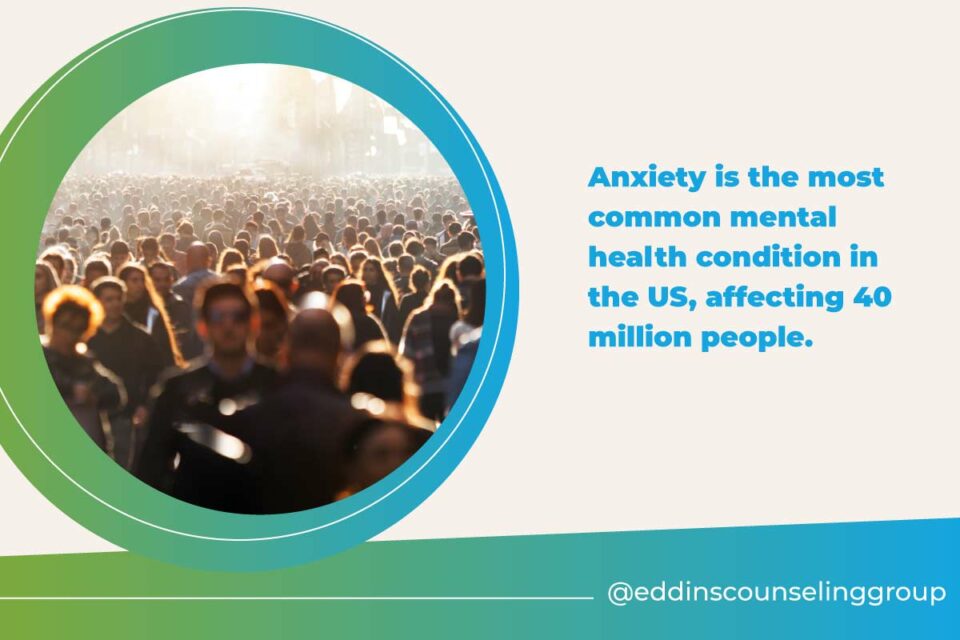
“Anxiety” might also present as adjustment disorder (presentation lasts less than 6 months and is linked to an identifiable stressor), social anxiety disorder (an intense, persistent fear of being watched and judged by others), or even PTSD.
Adjustment Disorder
If you’re anxious for three months and it’s really bad, but then it ends, that would probably be classified more as an adjustment disorder, something that lasts less than six months but is clearly to identifiable stressor.
Social Anxiety Disorder
We also have social anxiety disorder, which is persistent only in social settings and not overall. You’re not anxious about death or other things that generally bring people anxiety versus you’re only anxious about how people think of you, what they think of you, when they think of you, all of those kinds of questions.
To paint a clearer picture of what that looks like in a few common manifestations of anxiety that are diagnosable and clinical to differentiate from what we might be seeing out in the world, that people are calling anxiety, and internalizing our anxiety.
Semantics are important to describe what’s happening in a way that validates the people who are struggling with anxiety, but also still gives people who don’t have clinical anxiety a space to describe that and still have that, but have a differentiation between that.
The more that we can help with that, the better. Sometimes people might be described as having an anxious personality, but that doesn’t necessarily mean that they are clinically anxious by these definitions.
Clinically diagnosed anxiety and trauma disorders like PTSD are only diagnosed if the effects of a condition significantly impair an individual’s quality of life.
That’s like DSM 5.1.1. for diagnosing clinicians. If you worry about stuff, but it doesn’t keep you from doing what you want to do in life, then it’s probably something that you could consider more normative than something clinical or on the more severe side or the moderate side of anxiety.
- With depression, it’s: “Oh, I can’t get out of bed. I’m too depressed”.
- For anxiety, the most severe of that is: “Oh, I can’t leave the house. I’m too anxious.”
Put that into perspective. That’s a direct impairment on quality of life that is easier to look at in a clinical manifestation.
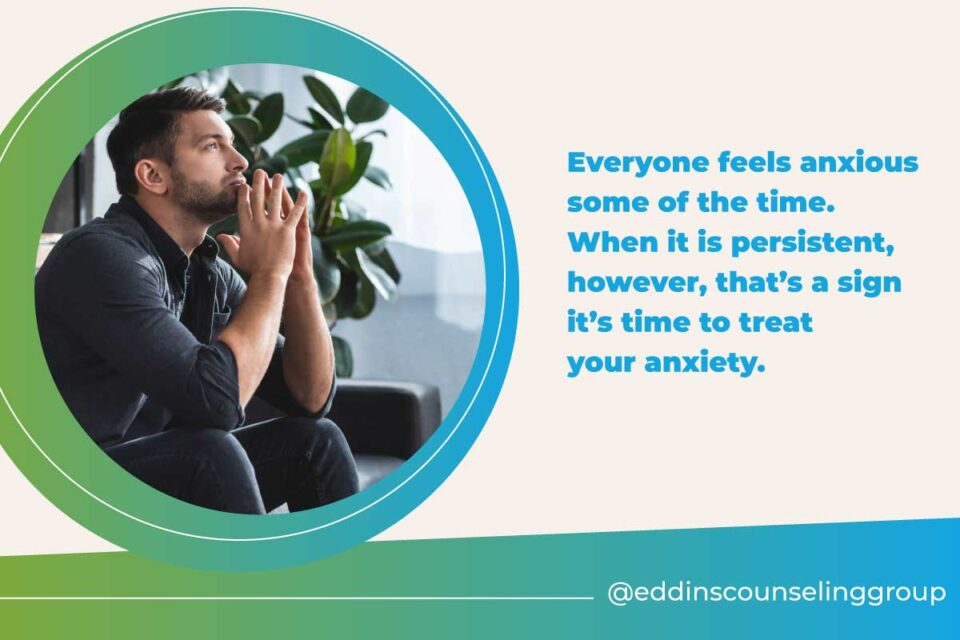
Why Do We Even Get Anxious?
How did we become perfectionists?
None of us are choosing to be anxious. It’s not fun. It’s not something that anybody wants to be. Then how did we become perfectionists? How did “perfect” become the bar? Why isn’t it okay for us to get A’s on tests? Why isn’t it okay for us to not be the perfect husband or wife or partner or whatever we’re trying to be?
The human brain hasn’t had an “update” in hundreds of thousands of years!
The same brain that was telling us: “Oh, a tiger bit you once. Maybe you should be afraid of those because it’s not fun to run into a tiger like that.”
That same brain is here telling us: “Oh, you know what? You bombed that test. Maybe you’re just not cut out for college. Or maybe you’re just bad at math or like.”
Or, you got dumped in a relationship. Maybe relationships are hard for you.
That’s not as helpful and informative as it used to be when we were running away from predators or we were at a constant survival risk.
Those same things that are triggering that for us in those moments are coming back biologically to try and trigger us now to keep us safe.
Avoidance is a hallmark of anxious thinking as a result. We have a negative thing happen to us. We want to make sure it doesn’t happen again. The easiest way to make that happen is to avoid it.
If we never encounter it, then we won’t have a hard time. If we actively try to keep it away, then it can’t hurt us.
But, then that brings us to the point where how much of that can we avoid in this modern world, depending on what the anxiety is, the severity of it, and how it’s popping up for you because eventually, that runs out.
Anxious and perfectionist tendencies are not just learned behaviors or a manifestation of your individual personality. They are also genetic.
Those anxious, perfectionist tendencies are not just our biological brain telling us something may be wrong here, but it’s also something we learn from the people around us.
We learn that it’s helpful to be anxious because then we can keep bad stuff from happening to our children, relatives, or friends. We have parents teaching kids (maybe indirectly), to be prepared for certain things in this way, to keep themselves safe.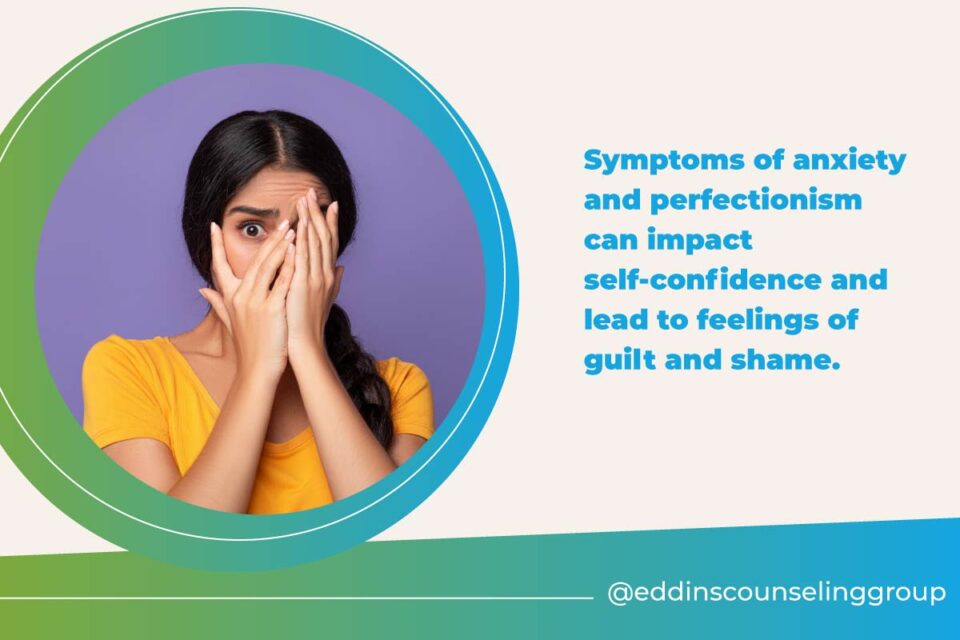
How To Get Over Driving Anxiety
I have a client who has a severe driving phobia. When we talked about it a little bit more to figure out how that developed for them over time, they said:
“My mom used to be afraid to drive at night. She wouldn’t drive on certain roads. She would actively shake at the wheel and pray out loud while she was driving us around.”
That behavior reinforces kids with a blank slate coming into it. They start to think that this is how they should cope with it. Maybe it’s not even a conscious decision either. Eventually, those learned behaviors can come out whether or not we’re consciously choosing to do that.
They’re also not just a manifestation of your individual personality. Some people don’t have anxious parents or anxious relatives, but they’re anxious. Sometimes that’s a personality thing, like an individual.
There’s a lot of genetic correspondence with anxious and perfectionist tendencies.
There’s also a piece of attachment that can create anxious or avoidant tendencies in life. That’s determined in the first 18 months or so of life before you are consciously making decisions about how you’re going to attach to somebody or not.
That all plays a role in how we get anxious, and how we get to be perfectionists. There’s a lot that is in our control, but also a lot that wasn’t or that was handed down to us.

Sometimes anxious thinking and perfectionism develop as a response to trauma. If you’re perfect, nobody can be mad at you! If you anticipate every outcome, nothing bad can happen! Not really…
That doesn’t always work. When I think of this, I think of children of alcoholic parents, and children of first-generation immigrants (not to generalize).
Sometimes these demographics can be susceptible to an overcompensation process, resulting in a third parent who ends up being responsible when the “real parents” in the family dynamic are unable to act according to their role (whether that’s a language barrier or intoxication).
Without that external locus of control, there is a heightening of the inner locus of control that becomes overdeveloped. That demonstrates a lot of resilience within those people, but it also over-emphasizes the ability to control the actions or feelings of others when that’s not possible. That is a powerful coping mechanism that makes us responsible for everything that’s happening around us.
Once that coping mechanism gets dismantled, or if it were to be, then the realization would be that everyone is terrible.
For example: “My mom didn’t hit me because I was a bad kid when I was a child. She hit me because she was a bad mom.” The realization then becomes the weight is no longer on you. It was on somebody else.
That can create a huge amount of depression. That can create a huge struggle to integrate identity into the rest of the world because all of a sudden, people are a lot worse than you thought they were because you just thought you were the problem.
It can be a really hard point within the trajectory of treating anxiety. The semantics of that start to take the curtain off of all of that pain that that coping mechanism was designed for.
Similarly, when you look back at your own family medical history, you might see that all women on one side have the same wild way of thinking.
Sometimes anxiety hides between that because, without healthy coping strategies, it can similarly lead to depression or substance use.
That unmanaged anxiety actually does the exact thing it was supposed to help you do but inhibits the way that you actually want to live your life or socially would want to be living your life to be able to have solid connections and relationships with other people.
Cognitive Dissonance
(and why it makes anxiety and perfectionism feel miserable)
Cognitive dissonance is “The state of having inconsistent thoughts, beliefs, or attitudes, especially as relating to behavioral decisions and attitude change.”
Distress only grows as you continue failing to meet “perfect” standards or face anxiety-producing events you could not control or predict.
You can visualize this by imagining you were pulling apart something. On the one side, you want to live a healthy lifestyle, but you have trouble exercising regularly, or you eat too much fast food, or whatever is getting in the way of that.
You know what’s better for you and what you should be doing.
Why is what you’re thinking not matching up with what you’re doing?
That eventually can create a huge sense of physical stress because your body and brain can’t compute the differences in actions and things that you’re doing.
With anxiety perfectionism, this feeling is even stronger than it would be for a neurotypical person because you’re putting in an extra amount. It’s an extra amount of heavy to have going on in your head because the pull on either end is weighted a lot stronger than they are for someone who just has a natural dissonance between two different attitudes or beliefs.
The distress for perfectionism only grows because you’re continuing to fail to meet perfect standards or face anxiety-producing events that you couldn’t control or predict over and over and over again.
It becomes this intensely uncomfortable mental space where you’re just feeling at war with yourself. This can lead to feelings of shame and guilt, which are super hard to overcome in terms of how you integrate that into your version of self because it just makes it so hard to believe that you could do anything better than what you already tried to do or failed to do.

The Anxious Brain’s Response to Stress
For someone with clinical anxiety, the brain is working overtime to protect you from perceived threats.
What was once a biological mechanism designed to protect you from harm is now a series of spiraling “what ifs?” that keeps you up at night or from focusing in class or on conversations.
Symptoms of ADHD and anxiety often overlap, causing people to question whether they are anxious because they can’t pay attention, or can’t pay attention because they are anxious!
This battle presents this dynamic of worried voice versus false comfort, which is that “what if” versus the brain trying to calm itself down. Like for example, if a worried voice tries to persuade you are a horrible person because someone told you that. And the false comfort trying to persuade you that is simply not true.
The worried voice will keep coming up with reasons why you should entertain this idea that you’re a horrible person, while false comfort keeps trying to tamp you down with logic.
The only voice in there that has any say to diffuse this is the voice of acceptance, which is “I’m having this thought right now, and that’s not really in line with the person that I am. I’m going to release this thought. I’m going to choose not to pay attention to it.”
There’s a lot of work that goes into that worried voice and false comfort, mitigation with acceptance. But part of it is knowing that you’ve gotten caught in a loop, and we’re not going to get anywhere by having both voices argue over each other inside your head about what is reality and what’s not.
There are a lot of different mental health conditions that overlap with ADHD, anxiety, or trauma that compound each other in the way that it’s difficult to pay attention because being hypervigilant is a trauma response.
But also it could be hard to pay attention because your brain is going a thousand miles an hour and it always has done that. That’s how you intake information versus your brain going a thousand miles per hour because you’re in an anxious spiral.
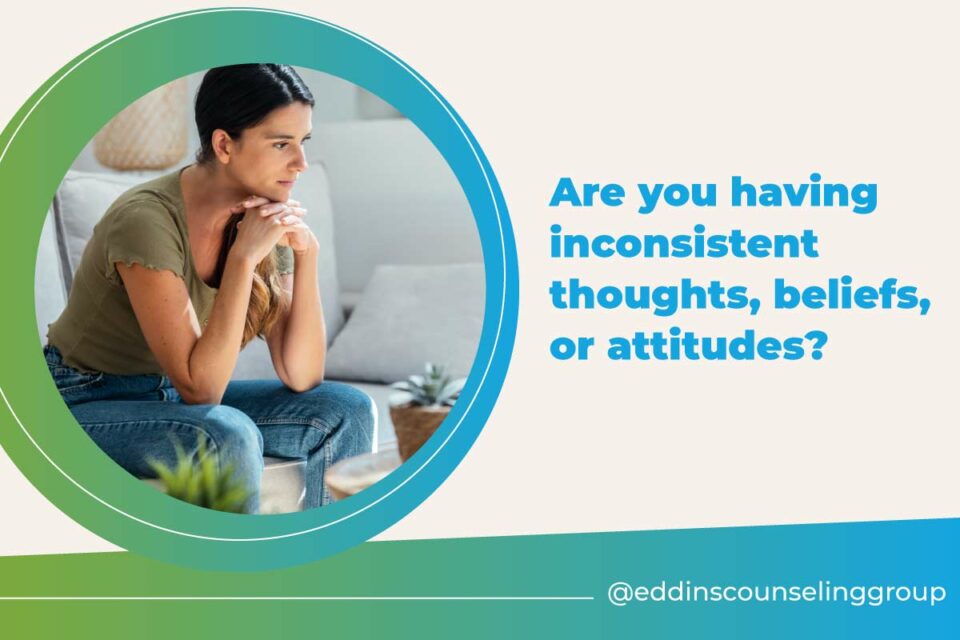
There are all sorts of ways to disentangle different conditions.
That’s a therapist’s job. It’s not any of your job. But that makes it a little bit harder sometimes to figure out if it’s anxiety or something else. And trying to mitigate that too.
We have biology in the back of our brain here, which is our survival brain thinking we should freak out. On top of that, we have dueling voices in our brain to try and get us to calm down, but also to hype us back up to trust that that biological cue in the back of our brain is real and that we should be worried about that.
Then we have this other layer that thinks it might not be anxiety that’s creating all of this stress for you. It could be all these other conditions that are unmanaged or that are compiled on top of each other to make this difficult.
You’re literally working against your outdated brain. That is a really hard thing to do successfully.
In that anxious moment, the front of your brain, which is the part of your brain that helps you use language and make choices based on things you’ve learned in the past, is no longer functioning when you’re up there.
To expect yourself to be able to manage the back part of your brain with the front part of your brain when they were designed for very different reasons is impossible.
Whether they have anxiety or something else, nobody can manage that part of their brain that way. That’s why I like to bring up the physiological aspect and all of these other more clinical aspects of this to just really drive home that this is a struggle for you not because you’re failing, but because it’s just a really hard system to try and override.
It is impossible to be anxious in a calm body.
Sound too good to be true? Try these things first…
If your body is calm, which is the driver of your biological anxious response, then your mind can’t be anxious. So if it sounds too good to be true, I have a few things that you can try to prove me wrong.
Try a breathing exercise
It’s cliche, but it’s recommended for a reason. Maintaining a steady breathing rhythm slows the heart rate which is naturally increased during an anxious response.
These exercises are recommended for a reason. When you get anxious, your heart rate shoots up. You start to breathe faster, and that starts to also influence how fast your heart rate is going.
All of those start pitching in a little cycle to elevate your system. Maintain a steady breathing rhythm. Breathe in different ways.
A diaphragmatic breathing exercise is a good one where you put your hand on your diaphragm and your belly. To practice filling your entire diaphragm with air and then expelling it. Then noticing how fast you’re breathing, the effort to slow breathing.
There’s also square breathing, which you can also watch on a screen if you watch a video. You can track with your eyes if you’re a very visual person, like how many counts in and out you’re supposed to be breathing.
There are various breathing rhythms or strategies for yoga that are meant to help you calm down while you’re working through the physical process. One of them is breathing in through the nose and out loudly through the mouth.
There’s also another version of that which is called cool breathing where you breathe in through your tongue and your teeth, and it feels cold when you breathe in and then you breathe out through your nose.
We also have a lot of smartwatches, which can help you prove whether this works or not. When you’re feeling anxious and you’re wearing your watch, you have a really good piece of biometric data to support that. It’s tracking that biometric data to offer you that suggestion because that is the remedy to essentially the biological response to anxiety.
If you’re on medication that increases heart rate, is there a way to achieve a calm state?
That goes back to your baseline heart rate. We’re just talking about when the anxiety elevates the heart rate and not your baseline heart rate. If your baseline heart rate is elevated all the time because of medication, we’re now talking about the heart rate on top of that when you’re having an anxious moment. That can be mitigated by breathing still.

Begin a daily mindfulness practice
Mindfulness is NOT meditation! It’s easier to integrate into your schedule because you can be mindful while you are doing all of your normal activities and chores.
There are a couple of other options when you’re not in a panic attack or you’re not at the height of your anxiety. One of those options is to begin a daily mindfulness practice. Mindfulness has been portrayed a lot to mean meditation, and those are not necessarily the same thing.
You have to be mindful to meditate, but you do not have to meditate to be mindful.
Mindfulness is really easy to integrate into your daily schedule because you can be mindful while you’re doing essentially anything. You can be mindful while you’re exercising, cooking, or walking. You can be mindful anytime you want and for as long as you want.
Don’t make it a task. You don’t have to do it at the same time every day. But having that moment of being focused in the present draws your attention away from the thousands of other narratives that are going on in your head while you’re trying to plan the next three hours of your future or initiate anxious thinking.
Building that mindfulness from a neutral setting where you’re actively trying it out and changing the pathways that your brain is thinking front-focused or back-focused to the past or future, eventually becomes a coping strategy for stressful times and anxious times because you can take yourself out of that in-your-head moment.
That’s the eventual build-up. We build up from the neutral setting to noticing that you’re anxious. That can keep you from getting into the full panic attack mode. When you start to feel it, that becomes your physical cue.
It all just starts with trying to integrate that into your normal daily activities without trying to make it a whole new thing. To make it as easy on yourself as possible to just integrate it when you can or when you remember, and also to be kind to yourself when your thoughts drift, because that’s the great thing about mindfulness.
Meditation is hard because you’re not supposed to let your thoughts drift. Mindfulness is when your thoughts drift you can bring them back.
To start teaching you that you do have control over what’s going on in your brain. You can bring your thoughts back if they go somewhere you don’t want them to. That is the endpoint.
For some people, on the more moderate side of the anxiety scale, it takes about a year to reach a point of being able to consistently bring that back by themselves without a therapist’s help to call that to their attention or to go into full crisis mode to realize that.
This is a long process that starts with catching yourself and thinking and then implementing the changes and then maintaining the changes. These are not easy quick fixes. Even if you tried these before and they didn’t work, I would be interested to know more about how that happened.

Listen to a guided visualization.
If you don’t like any pre-recorded ones, you can always make your own that is personalized to you!
When I say guided visualization, it includes a book on tape for yourself, but walking through your mind. Imagine a place where you feel most calm, like a beach or the forest. Imagine the waves, like lapping your feet while you’re walking up and down.
A lot of those are written to help you fall asleep, but they can also be written for managing your high-anxiety moments. If you can’t find one, ask someone who you love or care about a lot, or someone whose voice you like to help you narrate one of these for you so that you can listen to that when you get stressed.
There are tons of creative ways to do that in addition to that. But that can also be a way of your unique guided visualization. If it doesn’t exist on the internet, you can make your own.
It’s another time for you to come down into your body from your head and have somebody narrating something along with you to keep you in a more calm state.
Confronting Perfectionism: Black & White Thinking
Perfectionism is rooted in what therapists call “black-and-white thinking.” You might have also heard this called “all or nothing thinking.” It means that you give 100% or 0%. You’re either committed to the party (and all that entails) or you’re staying at home having no fun at all.
That attitude stems closely from anxiety because it’s like the trauma way of thinking. That same line of thinking is very much related to the perfectionist black-and-white scenario. Because you’re either perfect or you weren’t worth it.
Sometimes black and white thinking can also have its roots in different cultures. These can be family cultures or larger cultural groups.
Like for example, if you don’t go to church, some people would say you’re not a believer and you don’t believe in God. Or if you don’t get good grades, then you can’t be smart because you didn’t do well in school.
That doesn’t mean you’re not an intelligent person. Some of those lines of thinking depend on your external system rather than your internal system. They’re reinforcing you to have that thinking.
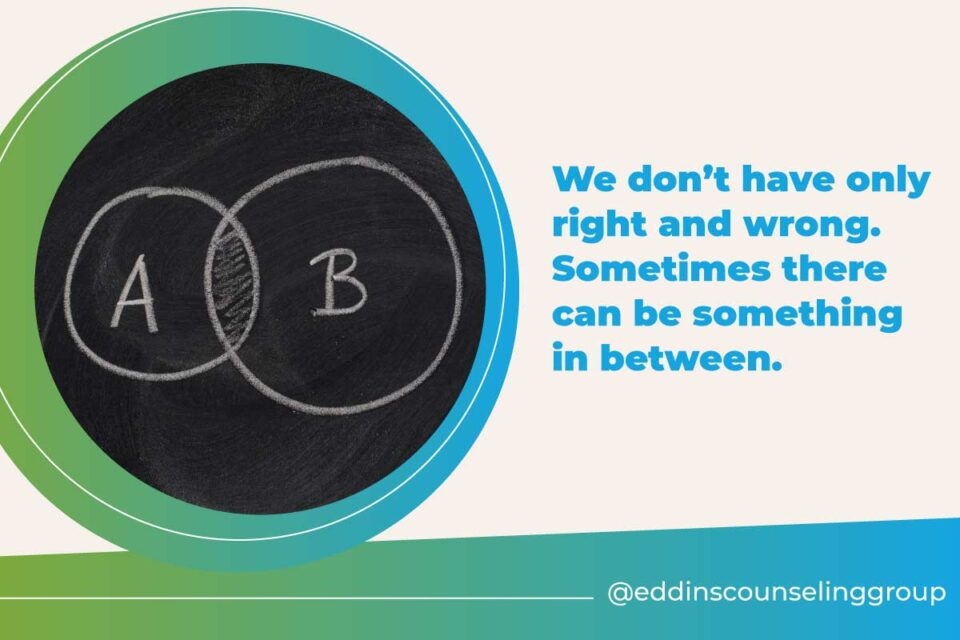
The solution? Lean into the gray.
- Acknowledging more than two solutions to a problem generates empathy and open-mindedness towards others, improving your interpersonal relationships.
- Practice thinking in terms of probability versus possibility. One of these is fueled by an acknowledgment of chance and acceptance of that. The other is fueled by anxiety.
- Think critically about what makes you uncomfortable with the gray. Is it a moral or ethical hang-up (e.g., right vs. wrong)? Who or what taught you that and how does gray resonate with your identity now?
What happens when we lean into the area between zero and 100? We’re acknowledging that more than two solutions to a problem can generate empathy and open-mindedness toward others, which improves your interpersonal relationships. Being a little bit more flexible can allow other people to be their true selves with you. This way you have a closer relationship with someone from that.
We don’t have only right and wrong. Sometimes there can be something in between. That can be uncomfortable to explore. We are not borne with the sense of black and white. That’s something that we generate over time.
Practice thinking in terms of probability versus possibility. One of these probabilities is fueled by an acknowledgment of chance and acceptance that some things are up to chance. The possibility is fueled more by anxiety.
There’s a possibility that a lot of things could happen. But how probable is it that it will happen? The difference here is, again, acknowledgment of chance and acceptance that there’s a chance.
Why is all of this so important now as a young adult?
That depends on what your definition of a “young adult” is!
- Identity vs. role confusion (12-18)
- Intimacy vs. isolation stage of development (19-40)
The last thing here is why is all this so important if you’re a young adult. To answer that, I have another question, which is what your definition of a young adult is. The person who came up with the stages of development that we know today did that in 1950. Freud came out with his psychosexual stages of development earlier than that.
We’re talking about a 19-40-year-old in the 1950s or a 12-18-year-old in the 1950s versus those people now. I included both of these areas here because I feel like the average 18 to 20-year-old in 1950 was looking at getting married and starting a family within two to five years. Now it’s a little bit more shocking to hear about an engagement straight out of high school or while actively enrolled in their undergraduate degree.
That puts these age brackets for the developmental milestones we’re supposed to be hitting at these times a little differently. This is because our average 18-20-year-old today is probably having a little bit more issues with identity versus role confusion. This is the stage where you explore who you are in the context of relationships and social environment, who you prefer sexually, what you want to study, what career you want to have, and more.
All of the identity-related questions versus someone who’s in an intimacy and isolation stage of development come after really solidifying those closer, family-oriented relationships or partnerships, and making sure that that is met.
Some evidence suggests that when these developmental stages get skipped or halted, it creates issues later on in life. Being so preoccupied with anxiety and perfectionism could lose you your true identity. This is the identity that you otherwise would have had if you weren’t too focused on what other people thought of you, and what expectations were on you.
That can cost you your closer, more familiar relationships. Generating feelings of loneliness and isolation where the intent of the anxiety was to try and get you those relationships, to try and keep you from saying something uncouth or uncool, that would keep you from being able to make those relationships. It becomes a double-edged sword that actually knocks you down.
Again, that’s why it’s important as a young adult because you’re going through either of these phases of life. The identity versus role confusion, intimacy versus isolation, and hang-ups on anxiety and perfectionism. They keep you from reaching that version of yourself that you otherwise would have if that wasn’t the preoccupation.
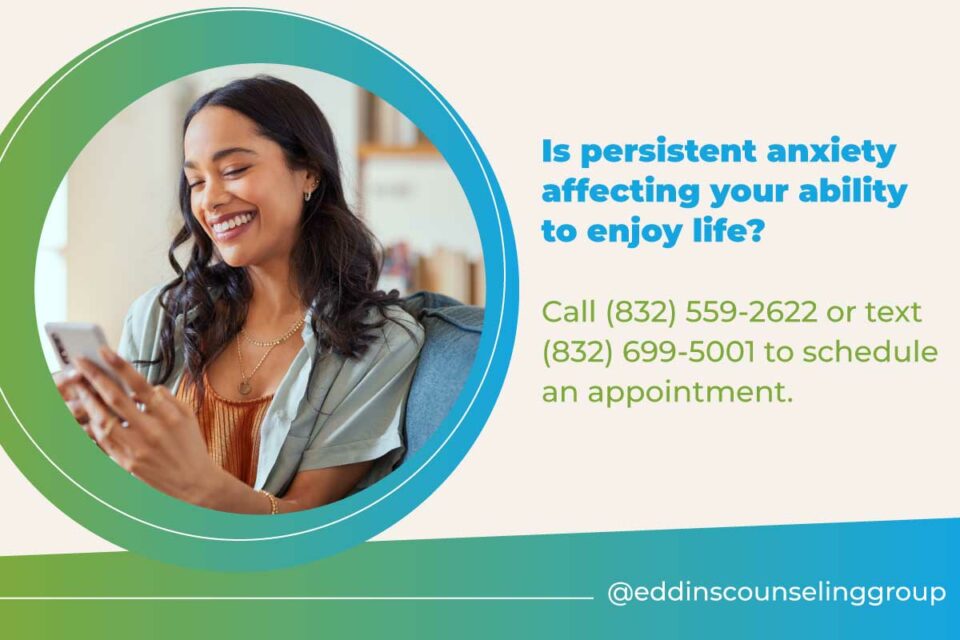
Recommended Reading
- Overcoming Unwanted Intrusive Thoughts: A CBT-Based Guide to Getting Over Frightening, Obsessive, or Disturbing Thoughts – Martin N. Seif & Sally M. Winston
- The Happiness Trap – Russ Harris
- Behave: The Biology of Humans at our Best and Worst – Robert M. Sapolsky
- The Mayo-Clinic Guide to Stress-Free Living – Amit Sood
- The Body Keeps the Score: Brain, Mind, and Body in the Healing of Trauma – Bessel van der Kolk
If you’re interested, this is my email address [email protected]. If you want to reach out directly with any questions, set up a free 15-minute consultation. For more information call (832) 559-2622 or text (832) 699-5001.
I appreciate you guys joining me today. I hope that you got what you needed from this. Again, this is very introductory. I crammed a lot of what I talk to my clients about in hours of time into like 50 minutes. I hope that it was helpful to you all. Hope that you are all able to take something from this and apply it when trying to manage anxiety and perfectionism.
5 Ways to Reduce Anxiety
Get instant access to your free ebook.
Grounding & Self Soothing
Get instant access to your free ebook.
Create Healthier Thoughts & Feelings
Get instant access to your free ebook.
Why You Feel This Way
Get instant access to your free ebook.






